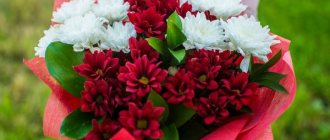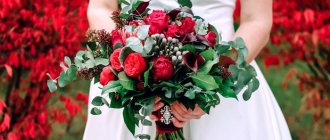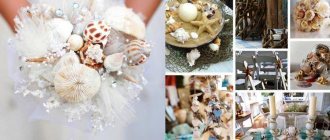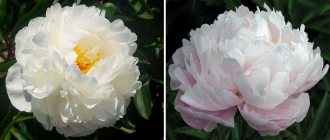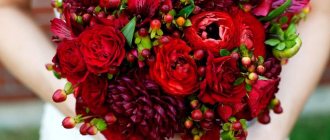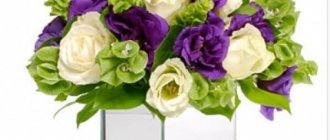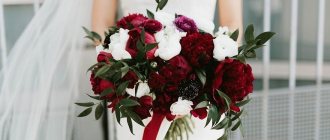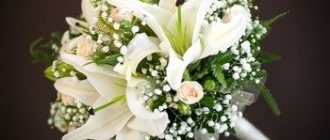Wedding bouquets made from wildflowers are gaining more and more popularity, as a trend towards unity with nature has emerged in Europe. Weddings in rustic and country styles are complemented with compositions with meadow plants. These buds fade faster than garden buds and are less stable. Meadow flowers can be kept fresh longer if you care for them properly.
The benefits of bouquets with wildflowers
Field plants in a wedding bouquet look attractive, but require special care. Without it, the buds will quickly wither, and the bride’s image will lose its original appearance. But if you manage to keep the plants fresh, the composition will delight the girl with its advantages:
- Roses and peonies are wedding classics. Therefore, guests will be surprised when they see the bride with wildflowers in her hands. But such an image will not leave them indifferent.
- A composition of field buds does not require a specific shade. Florists combine any tones, and they look advantageous. Variegated shades, taking into account the color type of appearance, harmoniously complement the image of the bride.
- Field plants are a budget pleasure. Therefore, the money saved will also please the newlyweds.
How to decorate
The field bouquets themselves look original and do not require any elaborate decorations, since they are based on simplicity and maximum closeness to nature, but you can still add small touches.
Field bouquets in wicker baskets look very stylish; this gives them a special charm. In addition, it is easy to hide a small floral sponge deep into the basket to preserve the freshness of the bouquet throughout the day.
The legs of compositions are also often decorated with ribbons. This allows you to avoid soiling of the stems themselves and at the same time gives the bouquet lightness and romance. Remember, you don’t need to be particularly sophisticated in decorating such a composition – naturalness will do everything itself.
Combination of bouquet and event style
Romantic girls who dream of a modest wedding with close people choose wild plants. The composition suits the decoration of the hall in a rustic style. Therefore, a rich, fluffy dress and a lavishly decorated hall suggest a bouquet with exquisite buds, and field flowers will look out of place and faded, and will be lost in the lush surroundings.
A bouquet of meadow plants is appropriate in the following styles: rustic, eco-style, Scandinavian minimalism, Provence, country, boho, vintage. Such compositions will organically fit into classical celebrations.
Weddings in country or rustic style suggest unity with nature, so newlyweds often choose a bouquet of wildflowers for such celebrations. Events in folk style also involve such compositions. Brides wear thin linen dresses with neat embroidery; this look is ideally complemented by compositions of meadow plants.
Wedding events in the summer outdoors involve carelessly assembled compositions that imitate buds just picked in the field. They complement the image by weaving similar plants into a wreath or into the bride’s hairstyle.
To link the natural beauty of plants and girls, a combination of meadow textures and greenhouse flowers is often used. Then the leading role is given to larger and brighter plants grown under artificial conditions, and field plants shade them.
Rituals for the groom
Although there are mainly wedding signs for the bride, before and during the wedding the groom must also observe several customs.
- To seal the union, the groom must carry the bride across the bridge.
- After the wedding, coins are placed in the groom's wine glass and kept away from prying eyes.
- The groom can place a coin under his right heel for good luck. This custom is also relevant for the bride.
- The groom at the evening should dance only with the bride in order to maintain a strong marriage. In addition, you can dance with your mother-in-law for a short time.
There is a long-standing tradition of planting young ones on the skin with the fur facing up. It is believed that then peace and prosperity will reign in the family, and the family itself will adhere to established traditions, where the husband is the head of the family and the breadwinner.
Flowers for a bouquet
In Europe, wedding celebrations are increasingly being held in a rustic style. Brides do not choose fancy, bulky designs, but delicate bouquets with small, neat buds. For such compositions take:
- Chamomile. This cheerful flower, bringing positive emotions, looks original in the hands of the bride. Florists collect a bouquet of plants grown under artificial conditions. But field daisies can also be used if you pre-treat them and give them water. They differ in size: small medicinal ones and large ones, the size of a gerbera.
- Cornflower looks great with ears of barley, rye or wheat. Blue, purple, lilac, pink buds remain fresh for a long time if the leaves and shoots are cut off from below. The bouquet should be kept in water with fertilizers for cut plants.
- Dandelion. Small yellow balls lift the mood and decorate any bride's look. But dandelions require special care. They are not kept in the same vase with other plants, as dandelions will cause the flowers adjacent to them to quickly wither. The juice from the stems is difficult to wash off and stains your hands, so the stems are wrapped in a wrapper that will protect the hands and the bride’s outfit.
- Cotton. Cotton is a wildflower that is used for fall and winter weddings. It looks great with dried flowers and does not require careful care.
- Shepherd's purse. This plant complements compositions as decorative greenery; it fills the voids between the buds and creates additional volume. Shepherd's purse is not used as the main flower.
- Poppy. One of the brightest and most unusual meadow plants. Poppy will decorate any girl’s dress, flowers look spectacular with cornflowers and daisies. But the poppy has a short lifespan, so the later it is picked, the longer it retains its freshness at the wedding.
In addition, bouquets are collected:
- bells;
- mallow;
- St. John's wort;
- peas;
- solidago;
- buttercups;
- sunflowers.
Important Tips
- If the wedding is themed, then it is enough to explain the general style to the florist - and half the job is done. Vintage, rustic, loft and other fashion trends have recognizable details that, when used in a bouquet, will immediately make the accessory part of the overall picture;
- It is worth considering the appearance of the bride. It is still not customary to see a wedding dress before the celebration, but the bride can take a photo of a piece of fabric so that professionals can decide on suitable and conflicting shades. You can describe the outfit in general terms - flowing or lush, open or modest;
- Height and weight are also important in determining the shape and volume of the bouquet. Tall girls look great with cascading compositions or a scepter. Round and hemispherical bouquets are more suitable for short and plump people;
- It is better to avoid flowers with a strong smell, such as lilies, since the bride will have to hold the bouquet in her hands throughout the whole day, and the strong aroma can cause headaches or even allergies. If a girl still insists on such plants, consult a florist. Often the problem is solved by removing the stamens or after treating the buds with a special solution.
Important! The weight of the composition also matters - an armful of flowers is undoubtedly incredibly romantic, but by the end of the evening the bride’s hands will not thank you for it.
- The boutonniere should be purchased at the same time as the bouquet, since these two accessories must overlap in order to turn the couple into a single whole;
- It is best to order flowers directly from a florist salon and about a month in advance. This way, specialists will definitely have time to select all the necessary elements, because some plants may have to be delivered from afar.
Schedule the delivery of the bouquet on the morning of the wedding day. This way you don’t have to worry about the safety of the buds, because plants often require quite complex manipulations, which is not very appropriate in the pre-wedding bustle.
How to properly collect and store wildflowers
Garden plants are bought at flower shops, but it is better to collect field plants yourself. To do this, take a container into which you immediately place the stems. Otherwise, they won’t even last until home and will wither. To extend the life of the bride's bouquet, girls use the following tricks:
- Meadow plants are not plucked, but cut diagonally with a sharp florist knife or pruning shears.
- The cut stems are held in the hands as little as possible. From the warmth of the palms they wither, and the flowers shed their petals.
- They are not collected at noon. To do this, select the early morning, immediately after sunrise, when the plants are filled with night moisture and retain maximum elasticity in the stem and bud. Or they are cut in the evening, but this option is less suitable for wedding compositions. Because the flowers are dried out by the sun and will not last long.
- Picking flowers according to the rules is not enough. They need to be properly preserved so that they last longer with a fresh look:
- Flowers are sorted after picking. Poppies and dandelions are not kept in the same container, but cornflowers and daisies get along well.
- The ends of the freshly cut stems are immersed in hot water for half a minute.
- The processed part is carefully cut off.
- The water in the vase is fertilized with substances for cut stems.
- Vases are placed in a cool place. The containers can be placed in the refrigerator.
- Flowers should not be placed in a draft or near an air conditioner or heating radiators.
- Cut plants react poorly to direct sunlight, so it is advisable to place the vase away from the window.
- It is prohibited to place fresh vegetables and fruits that emit ethylene near meadow plants: pears, apples, bananas, peppers, potatoes, tomatoes. The gas is destructive and the petals will quickly fall off.
Additional Tips
To ensure you have the most beautiful bouquet of wildflowers, it is recommended to collect it directly on the morning of the wedding. This is feasible if good weather is expected, and the bride’s image does not require serious preparations.
If you wish, you can ask one of your relatives or friends to collect flowers and create the composition yourself. The groom's boutonniere should be from the same flower that plays the main role in the bride's bouquet. You can even make a mini-copy of her composition.
You need to cut flowers early in the morning or late in the evening, and then distribute them into different vases according to their type. Hard water is suitable for field plants; if possible, fertilizing should be added to it. If juice is released from the stems, which could ruin the bride’s dress, you need to put them in boiling water for a few seconds. The girl can first try to make the desired bouquet some time before the wedding. This way you can see how the plants are combined and practice arranging them.
Meaning of wildflowers
Meadow plants are chosen by brides who do not show their feelings in public. They are not attracted to pretentiousness and abundance. Having failed, such girls withdraw into themselves, deeply experiencing the misfortune. They have a rich inner world, but girls lack perseverance, determination and courage to achieve their goals. For a wedding bouquet, brides select flowers that suit them most in meaning:
- Cornflower is a sign of fidelity and happiness. In Japan, it symbolizes truth, simplicity and natural attractiveness.
- Chamomiles symbolize safety and unity with plants. This is the most sincere, innocent bud, meaning romantic love and at the same time strong feelings.
- Dandelion is a symbol of sunlight and warmth. The plant radiates positive energy and is pleasing to the eye. Dandelions are given as a sign of fidelity and devotion to a partner.
Forms of bouquets with meadow plants
For a wedding composition made from wild plants, brides choose from the following options:
- Basket. Mostly they choose wicker baskets made from natural material, which are decorated with ribbons, beads, lace, and bows. The shapes of the baskets are different: square, round, oval, rectangular, heart-shaped.
- Bouquet wrapped in paper or craft material. To prevent the wrapper from attracting too much attention, choose a discreet shade without patterns or inscriptions. At the request of the newlyweds, the wrapper is supplemented with phrases with declarations of love, but there should not be too many of them so that they do not distract attention.
- A composition on its stems, tied with a ribbon. With field plants this is the most common form. This composition looks laconic and attractive, nothing superfluous, but quite capacious.
- Bouquet in a flowerpot. The plant pot is made of dense materials. Cardboard is suitable for this.
- A fan bouquet on a floral or self-made frame.
Who is it suitable for?
Delicate shades of buds and a variety of colors contribute to the creation of truly unique compositions that will look perfect at a wedding in all styles:
- romantic;
- classical;
- shabby chic;
- vintage;
- Provence
To correctly complement the bride’s image, you should pay attention to tips from experts:
- For girls of short stature, a small bouquet is perfect, which will emphasize the neatness of the image. Usually small bouquets are made in a spherical shape, decorated with a bright satin ribbon.
- For tall girls, an asymmetrical cascading bouquet would be an excellent choice. Such a composition will not seem too small and will harmoniously complement any image.
- Unusual bouquets, such as ombre, are suitable for girls who are planning a wedding in a fancy style. New, interesting forms of flower arrangements will favorably emphasize not only the image of the bride, but also the entire atmosphere of the holiday.
- Young brides are perfect for bouquets in a minimalist, classic style using white flowers: roses, lilies and orchids. This composition will emphasize the girl’s youth.
Master class composition of wildflowers in the form of a fan
In order to collect a bouquet of wildflowers you will need:
- wire frame with bergrass greens woven into it;
- small-flowered purple-colored asters;
- orange freesias;
- small-flowered yellow chrysanthemums;
- pastel lilac eustomas;
- scissors;
- floral tape;
- pruner
Step-by-step instructions on how to assemble a composition from meadow plants:
- Let's prepare the flowers: clean the leaves from the stems, separate the branches into separate parts that will be more convenient to work with.
- We fold the frame in half and begin to assemble the stems in a spiral to the central assembly point of the structure. In the bergrass weave, we move the fibers apart and make a hole exactly in the middle of the future fan.
- For a fan arrangement, small-flowered bush plants are better suited than those with large buds. We collect flowers one by one. First the stronger, more persistent stems of bush aster, then yellow chrysanthemum and freesia. We insert the lisianthus into the frame last. It has the most fragile stem, making it the easiest to break.
- We periodically adjust the buds so that the bouquet maintains the given fan shape.
- We make sure that the composition is uniform on both sides. We periodically look at the reflection of the composition in the mirror so that we can understand how the bride will look with the bouquet in photos and videos.
- When all the plants are inserted into the frame, we check that there are no empty spaces or, conversely, too thick a cluster of buds
- We wrap the stems with floral tape. A fan bouquet is convenient to place on the table during the ceremony, when the bride needs to free her hands.
- Use pruning shears to trim off the excess length of the stems.
DIY compilation
Tools and materials
Before you start, prepare everything you need:
- The most important thing you will need is a well-sharpened pruning shears, because trimming the stems is necessary for any composition;
- A porta bouquet will make life easier. The floral sponge in it, of course, adds weight to the accessory, but at the same time retains moisture, which means even the most capricious peonies will not wither;
- You can’t do without durable floral wire. It will hold the leg or lid of the bouquet holder and allow you to give the composition the required shape;
- Decorative elements are no less important - paper, ribbon, fabric, and other decorative elements. You will have to secure them in a variety of ways, so have a stapler, glue and pins ready.
To work you will need:
- 9 large roses of the desired shade;
- 5 branches of spray roses a shade lighter;
- 3 sprigs of white gypsophila;
- floral wire;
- satin ribbon to match the buds;
- pruning shears or sharpened knife;
- scissors;
- transparent rhinestones;
- glue.
Step-by-step instructions with video
- First, let's prepare the roses - cut off the thorns and all the leaves. Keep in mind that the working surface is 5 cm from the beginning of the bud, then the stem begins;
- We arrange the flowers in a spiral, so that the buds form a circle. Large roses - in the center, then bush roses, and gypsophila along the edges;
- When everything is ready, we tightly tie the stems with floral wire, preferably in several circles in a spiral. We cut off all stems that fall below the specified length with pruning shears;
Advice! The leg is usually made 20 cm long, but if desired, you can vary it up or down. The main thing is that the resulting accessory fits comfortably in the palm of your hand.
- Cover the wire with satin ribbon. You can wrap the leg either entirely or only over the wire frame;
- Glue the rhinestones onto the tape in the right places.
A rather simple, but incredibly charming bouquet of fresh flowers is ready!
Another option on how to assemble an original bouquet is in this video:
Master class on how to make a bouquet of cornflowers
To create a meadow bouquet for a wedding we take:
- cornflowers of raspberry, pink and blue shades;
- frame made of rattan and bergrass;
- decorative tape;
- scissors;
- pruner;
- floral tape.
Instructions for making a composition of multi-colored cornflowers:
- We distribute the first blue cornflowers along the very edge of the frame, creating something like a wreath around the circumference.
- Add another shade. We place raspberry-colored cornflowers around the frame using a spiral technique. We remove additional buds from the stems, leaving only 1-3 flowers on the stem, which are as close to each other as possible and open.
- We apply the buds tightly to the frame so that they do not hang down. We constantly scroll through the composition in our hands and look at its reflection in the mirror.
- We constantly adjust the buds so that they do not fall through or form voids.
- We insert the smallest buds into the composition in groups to speed up the assembly process.
- We collect a bouquet in the shape of a hemisphere with an empty middle without flowers, where the original wicker frame is visible. When the composition is ready, tie the stems with floral tape.
- We cut the stems to the same length.
- We tie the stem with a decorative ribbon to match the color of blue cornflowers. We form a simple bow.
Master class on assembling a cornflower blue wedding bouquet:
How to assemble a composition from “daisies”
For a wedding bouquet of daisies you will need:
- daisies, in this master class their role is played by Bacardi chrysanthemums;
- light purple September asters;
- porta bouquet holder with sponge “oasis”;
- decorative light lilac ribbon;
- glue for fresh flowers;
- glue gun;
- beads in the form of white pearls;
- scissors;
- a glass vase that serves as a stand for a porta bouquet holder.
Step-by-step instructions for assembling a bouquet of meadow flowers in a porta bouquet with photo:
We lower the porta bouquet maker with the “oasis” sponge into the water until it is completely saturated. After that, we take out the porta bouquet and place it in a vase.
We cut the daisies to the same length. We cut the ends of the stems diagonally to make it easier to stick into the sponge.
We begin to fill the stand with plants. We stick the stems in carefully so that we don’t have to change the place, otherwise an air pocket will form and the flowers will wither. We try to assemble the composition so that there are no gaps between the elements. If there are still voids left, they can be filled with half-closed buds.
Apply glue to a small surface, a piece of cardboard will do. Dip the bead into the glue, press it against the petals and hold until the glue sets.
Hot glue the lilac ribbon to the leg. We wrap it to the end.

